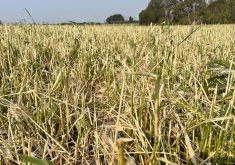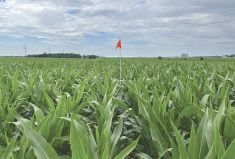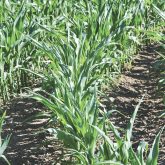Although widespread throughout southern Ontario and the U.S., corn is a crop you don’t normally associate with the colder Canadian Prairies. But don’t tell that to Monsanto, which is investing $100 million to develop early-maturing hybrids that the company hopes could make corn the new star in the West.
“I think there’ll be millions of acres of corn, and it’ll become a standard crop across Western Canada,” says Dan Wright, Monsanto Canada’s Canadian trait launch lead.
Monsanto turned heads in June 2013 when it announced a 10-year $100-million initiative to breed corn hybrids with earlier relative maturities (RMs) suited to the diverse geography and climate of Western Canada.
Read Also

Sensing the soil: Root cell research finds ‘stress hormone’
Research into how root cells react to soil stressors could help plants better adapt to changes in their climate.
The company predicts corn plantings in the West could reach eight million to 10 million acres by 2025, up from the current annual acreage of 300,000 to 500,000 acres, most of it in southern Manitoba. (If you’re doing the arithmetic, 2025 is just 10 years away.)
Monsanto’s bold predictions have even the biggest corn boosters wondering if the company is being overly optimistic, considering Manitoba isn’t exactly Iowa and growing conditions in the U.S. Midwest are different from those in the shorter-season Canadian Prairies.
“That’s a very lofty goal, to hit eight million to 10 million acres across the Prairies. That’s a very, very ambitious goal, in my opinion,” says Myron Krahn, who grows 500 acres of corn north of Carman, Man. “You’d need a year-over-year-over-year situation where the corn reaches full maturity without any blowups.
“What’s holding back a large expansion is earlier-maturing varieties,” adds Krahn, president of the Manitoba Corn Growers Association. “The varieties available take a lot of frost-free days and most of the Prairies doesn’t have those days. Our back is always up against the wall to winter. That’s a big challenge. You need consistently performing corn hybrids that mature every year and guys aren’t stuck with a bunch of corn left out in the field over winter.”
Even though he farms in the Red River Valley, the heart of Manitoba’s Corn Belt, Krahn says it’s often a stretch to accumulate enough heat units during the summer to be able to harvest corn before the deep freeze sets in. Don’t forget, too, that bad weather during the growing season can turn a promising corn crop into a costly disaster.
That’s what happened in the early 1990s, when corn acreage was just getting off the ground in Manitoba. A series of cool, wet summers with early frosts caused corn acreage to fall off the table. It took the crop years to recover.
But despite the risks, Wright insists Monsanto’s goals are achievable, especially as more early RM varieties come on the market. As proof, he notes that corn is moving steadily northward in the U.S. In North Dakota, it is already butting its head up against the Canada-U.S. border.
“As you see corn march north, you can say, why does it have to stop at the border? If we got the proper agronomics and yields available for growers, would they grow it? We think they would,” Wright says.
The news seems to be getting through. Corn acreage in Manitoba nearly doubled between 2010 and 2013. Grain corn increased from 166,369 acres to 322,965 acres while silage corn expanded from 42,409 acres to 76,858 acres. Acreages for both grain and silage corn were down in 2014 because of an unseasonably wet spring but the trend line is still upwards.
Also, more producers are turning to corn for the first time. Membership in the Manitoba Corn Growers Association has nearly doubled from 640 active growers in 2004 to 1,140 in 2014.
Some of the increases are driven by attractive prices. A prime example occurred in 2012 when a severe drought in the U.S. pushed corn prices above $8 a bushel. But another reason for the expansion is that recent advances in earlier-maturing varieties have made corn a viable option for growers in Manitoba and even farther west.
Some experimental early varieties are even out-yielding later-maturing varieties, says Terry Moyer, regional sales agronomist for Richardson Pioneer, a major seller of corn hybrids.
“We’re talking about varieties in the 2,100- to 2,150-heat-unit range outyielding stuff in the 2,250- to 2,300-heat-unit range,” Moyer says.
The key for corn to become an established crop, according to Moyer, is to develop early hybrids that can be harvested in late September or early October, instead of late October and early November, as is the case now. Another important factor is getting corn kernels to dry down faster in the field. Corn currently comes off the combine with moisture in the high 20 per cent to low 30 per cent range. Growers must then dry it down to a target content of 15 per cent for safe storage. A hybrid with moisture content in the high teens would result in less time and money spent by growers drying corn post-harvest, says Moyer.
“If we can get down to those levels at that time period — late September, early October — we will see corn acres go up exponentially,” Moyer says.
Developing varieties able to mature during a short growing season is only one challenge for Prairie growers. Another, especially for beginning producers, is the high cost of equipment, infrastructure and fertilizer needed to grow corn.
“It’s certainly a pricey crop to grow. It’s not cheap,” says Morgan Cott, the Manitoba Corn Growers Association’s field agronomist.
The first major investment is machinery. A corn seeder is virtually essential. You can use an air seeder to plant soybeans but it won’t work with corn. Farm equipment dealers say a new corn planter will run you around $245,000 to $250,000 while a slightly used one will still cost between $225,000 and $230,000.
The second major expense is a corn header for harvesting. Most standard headers pull the ears through the combine and leave the stalks partially standing, requiring a chopper or cultivator afterwards to incorporate the residue. Moyer says a new kind of header starting to appear in Manitoba cuts the entire stalk and sends it through the combine for shredding. An eight- to 12-row corn header with a chopping head can cost $125,000 new and $90,000 used.
Moyer says some headers come with under-cutters — discs spinning underneath the header — to cut the stalks off at ground level. A second attachment called stalk stompers will push down the remaining stubs and make them easier to work with a tiller. Still, the time and effort required to incorporate tough corn residue and make the field suitable for next year’s seeding has to be counted as an additional expense.
Then there are storage bins to consider. Since corn kernels need to be dried, most systems are based on three bins — one for wet corn, one for corn to cool after drying and a third for storage.
Don’t forget, too, that corn is a high user of nitrogen and phosphate — another added input expense for growers.
So far, we have a picture of an expensive high-risk crop. Corn takes a long time to mature, there’s always the risk of a short growing season and an early frost, and the cost of producing it is high. With all those risks, why would a farmer in Western Canada bother with corn?
The answers are simple. High-yielding corn can be quite lucrative and it also fits nicely into the crop rotation.
Krahn says 10 years ago, a Manitoba corn grower would be happy to harvest a 100-bushel-an-acre crop. Today, new improved varieties are pumping out 120- to 140-bushel yields consistently. Even with corn prices half of what they were a few years back, that’s still a powerful financial incentive.
Moyer notes corn is also a good fit for breaking up the rotation and reducing weed and disease pressure. Also, because it uses a lot of nitrogen, corn is a good crop to grow on manure-applied land in livestock-intensive regions. Livestock producers who grow corn can apply their manure right at home instead of hauling it miles to find fields on which to spread it.
Moyer says corn has come a long way in the last 30 years, when growers lacked the equipment, infrastructure and the earlier-maturing Roundup Ready varieties they have today. The disasters of the early 1990s are unlikely to repeat themselves even if Mother Nature throws growers another curve.
Despite all these advances, the fact remains that corn in Western Canada is a high-risk, late-maturing crop. For that reason, Krahn urges growers, especially new ones, to go slow and do their homework first.
“I would never be one to jump into it with both feet all at once. For a new guy, I would recommend you be cautious and temper your enthusiasm,” Krahn says. “Corn is a very exciting crop to grow but until you can prove you can consistently pull it off in your specific area, I certainly wouldn’t be dumping half my acres into corn the very first year of trying it.















